




Santa Monica High School
601 Pico Blvd.

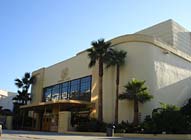
Main Entrance looking south - Barnum Hall - photo by Michael Grandcolas
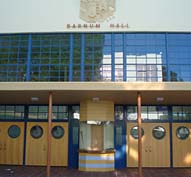
Entrance - Barnum Hall
photo by Michael Grandcolas
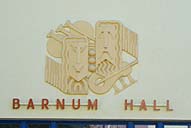
Comedy - Tragedy - Barnum Hall
photo by Michael Grandcolas
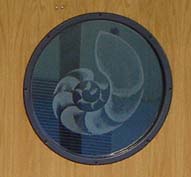
Nautilus Doors - Barnum Hall
photo by Michael Grandcolas
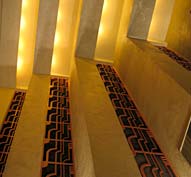
Interior Detail
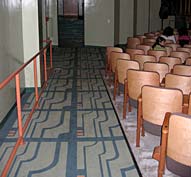
Carpeting
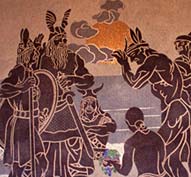
Landing of the Vikings in Vinland, 1939, mosaic in lobby of Barnum Hall theater at Santa Monica High School
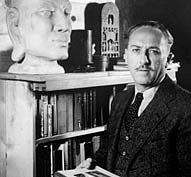
Stanton Macdonald-Wright
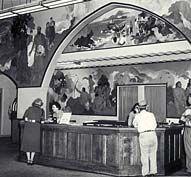
Circulation desk with Stanton MacDonald-Wright mural - 1950s
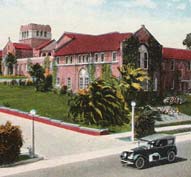
Santa Monica High School
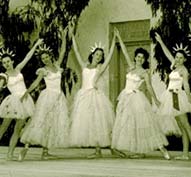
Santa Monica High School Greek Theatre - Symphonies by the Sea production, CA. 1940
Adelbert Bartlett
Originally known as the Santa Monica Civic Auditorium, it was designed by the firm of Marsh, Smith & Powell to be a cultural center to the Santa Monica community, hosting concerts, plays, musicals, even opera, ballet and guest solo artists.
A classic model of Public Works Administration streamline moderne style, the structure bears all the hallmarks of a style associated with steamships and deco movie theaters -- rounded corners, horizontal banding and porthole-like windows in the front doors. Even the side walls of the chairs are stamped with the name of the school in a moderne typeface.
W.F. Barnum, after whom the hall is named, served as Santa Moncia High School principal from 1916 to 1943 (and, per rumor, is a distant relative of the fabulous Phineas T.) "He was [here] forever," said Jean Sedillos who has helmed the "Restore Barnum Hall!" project. "The guy was a fixture." He spent long hours with architects Marsh, Smith and Powell, poring over the designs.
Doors opened in 1937. At that time the building was still unfinished.
Developers had run out of money, and the WPA refused to give them anymore.
The organ grille (behind which the organ pipes sit) was never manufactured.
Nor were there ever any seats in the mezzanine.
"Until now, [the organ pipes] were covered with chicken wire," Sedillos noted to the Ocean Park Gazette, "some sort of industrial mesh."
In lieu of the custom seating, the mezzanine was "papered" with chairs from a 19th-century venue. "Some theatre was going out of business in Santa Monica so they donated these Victorian seats that don't match." The seats are narrower ("People were much smaller then"), and boast metal racks underneath -- "metal things that held men's hats."
But there was money for art. Eminent Santa Monica artist, Stanton MacDonald-Wright directed leading WPA artisans to create such works as the Viking mural on the fire curtain and the mosaic in the lobby. Additionally on the front facade of the hall is a concrete bas-relief of a comedy-tragedy mask and musical instruments portrayed in the art deco style that was preeminent for many public buildings in the 1930's. Interior public areas of the building contain two noteworthy pieces of MacDonald-Wright artwork, a fire curtain mural and a large mosaic piece. The fire curtain mural is titled “Entrance of the Gods into Valhalla.” The mosaic piece in the foyer is called “Landing of the Vikings in Vinland.” FYI - The Santa Monica High School sports teams are called the Vikings.
“I did that because that's what the kids wanted there,” noted MacDonald-Wright in an interview with Betty Lochrie Hoag from May 5, 1964. “And then, of course, the mosaic is just the Vikings landing on the shore (let us say) of Santa Monica. And did you know that the gold and silver in that is real gold and real silver? There's no monkey-business about it! Those golds cost the government something!!"
When Stanton Macdonald-Wright arrived in Santa Monica in 1900 at the age of 10, Santa Monica was 25-years old and had only 3,000 residents. Always an iconoclast, Macdonald-Wright set out on a singular road as a boy and never wavered. Self-educated, astonishingly self-confident, contrary, he not only created a diverse, singular and influential body of work, he changed the course of American art.
Macdonald-Wright, with fellow American painter Morgan Russell, fathered the Synchromism movement. Convinced that color and sound were equivalent phenomena and that one could “orchestrate” the colors in a painting the way a composer arranged notes and chords in a musical composition, they developed a system of painting based on color scales. The system entailed constructing form and depth in a painting through advancing and reducing hues. Their ensuing “synchromies” were some of the first abstract non-objective paintings in American art.
Macdonald-Wright and Russell exhibited their new aesthetic first in Munich, then in Paris in 1913, and the following year in New York. Synchromism became the first American avant-garde movement that was recognized in the international arena.
Macdonald-Wright returned to Los Angeles in 1918 and quickly established himself as the foremost modernist in the region, and encouraged the development of a distinctively West Coast response to modernism.
He taught at the Chouinard School of Art (now the California Institute of the Arts), directed the Art Students League of Los Angeles, lectured and published his ideas on art aesthetics and philosophy, and eventually taught at UCLA. He is also credited with organizing the first exhibition of Modern Art in Southern California, the 1920 Exhibition of American Modernists at the Los Angeles Museum of History, Science, and Art (the forerunner of LACMA).
L.A art critic Merle Armitage described Macdonald-Wright as “a formidable man.” Distinguished director/writer John Huston, a most formidable man himself, once said, “S. Macdonald-Wright furnished the foundation of whatever education I have.”
The Great Depression, which seized America in the 1930s gave Macdonald-Wright a unique opportunity to create some large-scale works in Santa Monica - including the murals in the lobby of the Santa Monica City Hall, the fire curtain mural and designing the mosaic in the lobby of Barnum Hall, the theater on the Santa Monica High School campus, and an extraordinary mural cycle in the Santa Monica Public Library, the most extensive such project ever undertaken in Southern California. (When the old Public library was torn down, the mural was placed with the Smithsonian Institution where it has resided ever since.)
Architect Norman Marsh is best known for designing the many sculptures, plaques, reliefs, murals, and fountains at USC, several buildings on the UCLA campus and the founding buildings in Venice, California in 1904.
One of Barnum Hall's additional designers, Henry Alfred Buxton also worked on the design of (at the time) the Grauman's Chinese Theatre, now Mann's Chinese Theatre.
After sixty years of service, Barnum's portholed doors were closed in Aug. 1997. The rigging and the lighting system had become dangerous, from wear and lack of maintenance.
It was agreed that Barnum Hall would go through a five-year, $8 million in restoration. In addition to renovating the exisiting building, the walls were bent and baffled to remove an annoying echo.
"They didn't know much about acoustics in those days," Sedillos offered.
Organ chambers are being refurbished to house a 1920s Wurlitzer -- the kind that ceased to be built when talkies came in. The organ was donated by Samohi alumni J. B. Nethercutt. The Los Angeles Theatre Organ Society has agreed to maintain the instrument in exchange for being allowed to use it for two organ concerts a year.
Upon restoration, the property was re-landscaped, and foliage around Barnum Hall now includes six Washingtonia robusta palms, a multi-trunk European fan palm, two giant birds of paradise and pygmy date palms.
“Landscaping a beautiful building like Barnum has been a labor of love for all concerned,” stated Santa Monica High School Campus Beautification Committee co-chairs Judi Bloom.
Barnum Hall, like Santa Monica City Hall, is another fine example of PWA Moderne architecture. The Public Works Administration, under President Franklin Delano Roosevelt, spent over $6 billion on various public works, such as public buildings, bridges, dams, and housing developments, securing our nation's infrastructure while combating unemployment. Under the administration (1933-39) of Harold L. Ickes, the PWA completed a great many public projects. President Roosevelt's reorganization plan of 1939 made the PWA a division of the Federal Works Agency. The PWA was liquidated in the 1940s.
Santa Monica High School Campus
601 Pico Boulevard, Santa Monica, CA 90405
Box Office: 310-458-5939